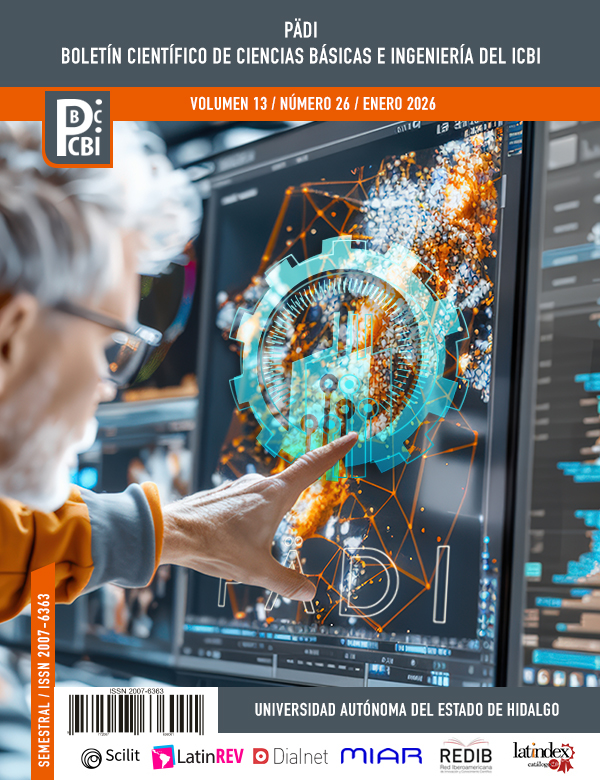Esquema de doble lazo de control para sistema de Iluminacion LED
DOI:
https://doi.org/10.29057/icbi.v13i26.12925Palabras clave:
Modelado, Simulación, Control de iluminación, Ahorro de energíaResumen
La creciente población mundial y el agotamiento de los recursos energéticos han intensificado el desafío de la conservación de energía, siendo los edificios responsables del 30 % al 40 % del consumo total de energía. La iluminación, que constituye hasta el 20 % del uso energético global, requiere estrategias innovadoras para su conservación. La tecnología LED, conocida por su eficiencia, sirve como una solución fundamental. En este trabajo, exploramos el esquema de control de doble lazo proporcional derivativo mas integral (PD ´ +I) con el fin de mejorar el ahorro energético de una lámpara LED y garantizar el confort visual. Se emplean modelos matemáticos, tanto lineales como no lineales, para la caracterización de lámparas y el diseño del esquema decontrol. Los resultados de simulación demuestran la efectividad del PD+I propuesto para lograr eficiencia energética en diferentes escenarios.
Descargas
Información de Publicación
Perfiles de revisores N/D
Declaraciones del autor
Indexado en
- Sociedad académica
- N/D
Citas
Chen, S. Y., Zhang, J., Zhang, H., Kwok, N. M., y Li, Y. F. (2012). Intelligent lighting control for vision-based robotic manipulation. IEEE Transactions on Industrial Electronics, 59(8):3254–3263.
Copot, C., Thi, T. M., e Ionescu, C. (2018). Pid based particle swarm opti- mization in offices light control. IFAC-PapersOnLine, 51(4):382–387. 3rd IFAC Conference on Advances in Proportional-Integral-Derivative Control PID 2018.
De Keyser, R. e Ionescu, C. (2010). Modelling and simulation of a lighting control system. Simulation Modelling Practice and Theory, 18(2):165–176.
Gorgülü, S. y Ekren, N. (2013). Energy saving in lighting system with fuzzy logic controller which uses light-pipe and dimmable ballast. Energy and Buildings, 61:172–176.
Khalil, H. K. (2002). Nonlinear systems; 3rd ed. Prentice-Hall, Upper Saddle River, NJ.
Konstantzos, I., Sadeghi, S. A., Kim, M., Xiong, J., y Tzempelikos, A. (2020). The effect of lighting environment on task performance in buildings ? a review. Energy and Buildings, 226:110394.
Kurian, C., Aithal, R., Bhat, J., y George, V. (2008). Robust control and optimisation of energy consumption in daylight?artificial light integrated schemes. Lighting Research & Technology, 40(1):7–24.
Le, N. P., Giap, L. N., Khanh, N. B., Trung, B. T., y An, T. N. T. (2019). Mathematical and simulation models of lighting automatic control system in according with natural light. IOSR Journal of Engineering, 9:45–52.
Pandharipande, A. y Caicedo, D. (2011). Daylight integrated illumination con- trol of led systems based on enhanced presence sensing. Energy and Buildings, 43(4):944–950.
Petrov, O. L. (2020). Research of effectiveness on led dimming lighting installations. En 2020 Fifth Junior Conference on Lighting (Lighting), pp. 1–3.
Pompei, L., Blaso, L., Fumagalli, S., y Bisegna, F. (2022). The impact of key parameters on the energy requirements for artificial lighting in ita- lian buildings based on standard en 15193-1:2017. Energy and Buildings,
263:112025.
Santamouris, M. (2019). Minimizing Energy Consumption, Energy Poverty and Global and Local Climate Change in the Built Environment: Innovating to Zero. UK.
Wen, Y.-J. y Agogino, A. M. (2008). Wireless networked lighting systems for optimizing energy savings and user satisfaction. En 2008 IEEE Wireless Hive Networks Conference, pp. 1–7.
Descargas
Publicado
Cómo citar
Número
Sección
Licencia
Derechos de autor 2025 Edgar Estrada-Cruz, Ismael Barrera-González, Victor Pedraza-Ramirez , Aixa-Fernanda Dawe-Perez

Esta obra está bajo una licencia internacional Creative Commons Atribución-NoComercial-SinDerivadas 4.0.




















